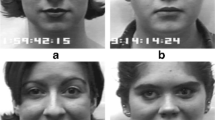Absract
This paper presents a new method for modeling of a personalized 3D face model that has a hierarchical structure of the skin, muscle, and skull for realistic expression synthesis. We start from an accurate facial mesh reconstructed from the individual face measurements. The deformable skin model has a multi-layer structure to approximate different types of soft tissue and takes into account the nonlinear stress-strain relationship and incompressibility of the real skin. The 3D face model incorporates the skull structure which extends the scope of facial motion and facilitates interactive facial muscle insertion. Under the muscular force, the deformation of the facial skin is evaluated by the numerical integration of the governing Lagrangian dynamics. The resulting animation system enables realistic facial expressions to be dynamically synthesized.
Similar content being viewed by others
References
Choi, C. S., Aizawa, K., Harashima, H. and Takebe, T., Analysis and Synthesis of Facial Image Sequences in Model-based Image Coding, IEEE Trans. Circuits and Systems for Video Technology, 4-3 (1994), 257–275.
DiPaola, S., Extending the Range of Facial Types, Journal of Visualization and Computer Animation, 2–4 (1991), 129–131.
Ekman, P. and Friesen, W. V., Facial Action Coding System, (1978), Consulting Psychologists Press Inc., 577 College Avenue, Palo Alto, California.
Hashimoto, S., Sato Y. and Oda, H., Modification of Facial Expression Using Spring Frame Model, Proceedings of IASTED, (1996), 9–15.
Kalra, P., Mangili, A., Thalmann, N. M. and Thalmann D., Simulation of Facial Muscle Actions Based on Rational Free Form Deformations, Proceedings of Eurographics’92, (1992), 59–69.
Parke, F. I., Computer Generated Animation of Faces, (1972), Master’s Thesis, University of Utah, Salt Lake City.
Parke, F. I., Parameterized Models for Facial Animation, IEEE Computer Graphics and Application, 2–9 (1982), 61–68.
Schroeder, W. J., Zarge, J. A. and Lorensen, W. E., Decimation of Triangle Meshes, Proceedings of SIGGRAPH’92, (1992), 65–70.
Sera, H., Morishima, S. and Terzopoulos, D., Physics-based Muscle Model for Mouth Shape Control, Proceedings of IEEE Interantional Workshop on Robot and Human Communication, (1996), 207–212.
Su, M. S., Ko, M. T. and Cheng, K. Y., Feature-point-driven Facial Animation using A Hypothetical Face, Computer Graphics Forum, 20-4 (2001), 179–188.
Terzopoulus, D. and Waters, K., Physically-based Facial Modeling, Analysis and Animation, Journal of Visualization and Computer Animation, 1 (1990), 73–80.
Van Gelder, A., Approximate Simulation of Elastic Membranes by Triangulated Spring Meshes, Journal of Graphics Tools, 3-2 (1998), 21–41.
Williams, L., Performance-driven Facial Animation, Proceedings of SIGGRAPH’90, (1990), 235–242.
Wu, Y., Kalra, P., Moccozet, L. and Thalmann, N. M., Simulating Wrinkles and Skin Aging, The Visual Computer, 15-4 (1999), 183–198.
Zhang, Y., Prakash, E. C. and Sung, E., A Physically-based Model with Adaptive Refinement for Facial Animation, Proceedings of IEEE Computer Animation 2001, (2001), 28–39.
Author information
Authors and Affiliations
Additional information
Yu Zhang: He received his BE in 1997 and ME in 1999 from Northwestern Polytechnical University, China. He is currently a Ph. D student in the School of Electrical and Electronic Engineering, Nanyang Technological University, Singapore. He is a student member of IEEE Computer Society and ACM SIGGRAPH. His research interests are Computer Animation, Physically-based Modeling, 3D Visualization, and Virtual Reality.
Edmond Cyril Prakash: He is an Assistant Professor of Computer Science at the Nanyang Technological University, Singapore. He received his BE, ME and Ph.D degrees from Annamalai University, Anna University and Indian Institute of Science respectively. Edmond’s research focus is on exploring the applications of virtual reality in engineering, science, medicine and finance. He also serves as a Deputy Director for the Financial Engineering program at NTU, Singapore.
Eric Sung: He graduated from the University of Singapore in 1971 with BE (Hons), and an MSEE from the University of Wisconsin in 1973. He taught at the Singapore Polytechnic from 1973 to 1978. In 1985, Eric Sung joined Nanyang Technological University as a senior lecturer. He obtained his PhD from Nanyang Technological University in 1999 and is currently an associate professor. His main research interest are in computer vision, intelligent automation and image processing concentrating on stereovision, structure from motion and face recognition problems.
Rights and permissions
About this article
Cite this article
Zhang, Y., Prakash, E.C. & Sung, E. Hierarchical facial data modeling for visual expression synthesis. J Vis 6, 313–320 (2003). https://doi.org/10.1007/BF03181472
Received:
Revised:
Issue Date:
DOI: https://doi.org/10.1007/BF03181472




